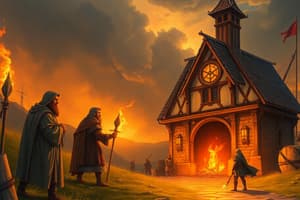Podcast
Questions and Answers
What was the time period during which Old English was spoken in England?
What was the time period during which Old English was spoken in England?
- 5th to the 11th centuries (correct)
- 4th to the 10th centuries
- 3rd to the 9th centuries
- 6th to the 12th centuries
What is the name by which Old English is also known?
What is the name by which Old English is also known?
- Old Norse English
- Anglo-Norman
- Germanic English
- Anglo-Saxon (correct)
What is the characteristic of Old English grammar?
What is the characteristic of Old English grammar?
- It has a simple system of case endings and grammatical inflections
- It has a mix of simple and complex systems of case endings and grammatical inflections
- It has no case endings and grammatical inflections
- It has a complex system of case endings and grammatical inflections (correct)
What is the number of cases in Old English grammar?
What is the number of cases in Old English grammar?
What is the origin of Old English vocabulary?
What is the origin of Old English vocabulary?
What is the characteristic of Old English literature?
What is the characteristic of Old English literature?
What alphabet was initially used to write Old English?
What alphabet was initially used to write Old English?
What emerged as the dominant dialect of Old English in the 9th century?
What emerged as the dominant dialect of Old English in the 9th century?
Flashcards are hidden until you start studying
Study Notes
General Characteristics of Old English
Language
- Old English was a Germanic language, closely related to Old Norse and Old Frisian
- Spoken in England from the 5th to the 11th centuries
- Also known as Anglo-Saxon
Grammar
- Inflected language with a complex system of case endings and grammatical inflections
- Four cases: nominative, accusative, genitive, and dative
- Two numbers: singular and plural
- Three genders: masculine, feminine, and neuter
Vocabulary
- Derived from Germanic roots and influenced by Latin and Celtic languages
- Many words related to everyday life, such as food, clothing, and household items
- Limited vocabulary for abstract concepts, such as philosophy and science
Literature
- Old English literature was largely oral, with stories and poems passed down through generations
- Surviving texts include epic poems, such as Beowulf, and shorter poems, such as The Wanderer
- Christian influence on literature, with many works translating Latin texts into Old English
Alphabet
- Runic alphabet used in early Old English period, replaced by Latin alphabet with the introduction of Christianity
- Additional letters, such as þ (thorn) and ð (eth), used to represent unique sounds in Old English
Dialects
- Four main dialects: Northumbrian, Mercian, West Saxon, and Kentish
- West Saxon emerged as the dominant dialect in the 9th century, used in most surviving texts
Language and History
- Old English was a Germanic language spoken in England from the 5th to the 11th centuries.
- It was closely related to Old Norse and Old Frisian, and also known as Anglo-Saxon.
Grammar and Structure
- Old English was an inflected language with a complex system of case endings and grammatical inflections.
- It had four cases: nominative, accusative, genitive, and dative.
- There were two numbers: singular and plural, and three genders: masculine, feminine, and neuter.
Vocabulary and Influences
- Old English vocabulary was derived from Germanic roots and influenced by Latin and Celtic languages.
- Many words were related to everyday life, such as food, clothing, and household items.
- However, there was limited vocabulary for abstract concepts, such as philosophy and science.
Literature and Oral Tradition
- Old English literature was largely oral, with stories and poems passed down through generations.
- Surviving texts include epic poems, such as Beowulf, and shorter poems, such as The Wanderer.
- Christian influence was evident in literature, with many works translating Latin texts into Old English.
Alphabet and Writing System
- The runic alphabet was used in the early Old English period, replaced by the Latin alphabet with the introduction of Christianity.
- Additional letters, such as þ (thorn) and ð (eth), were used to represent unique sounds in Old English.
Dialects and Regional Variations
- There were four main dialects: Northumbrian, Mercian, West Saxon, and Kentish.
- West Saxon emerged as the dominant dialect in the 9th century, used in most surviving texts.
Studying That Suits You
Use AI to generate personalized quizzes and flashcards to suit your learning preferences.




